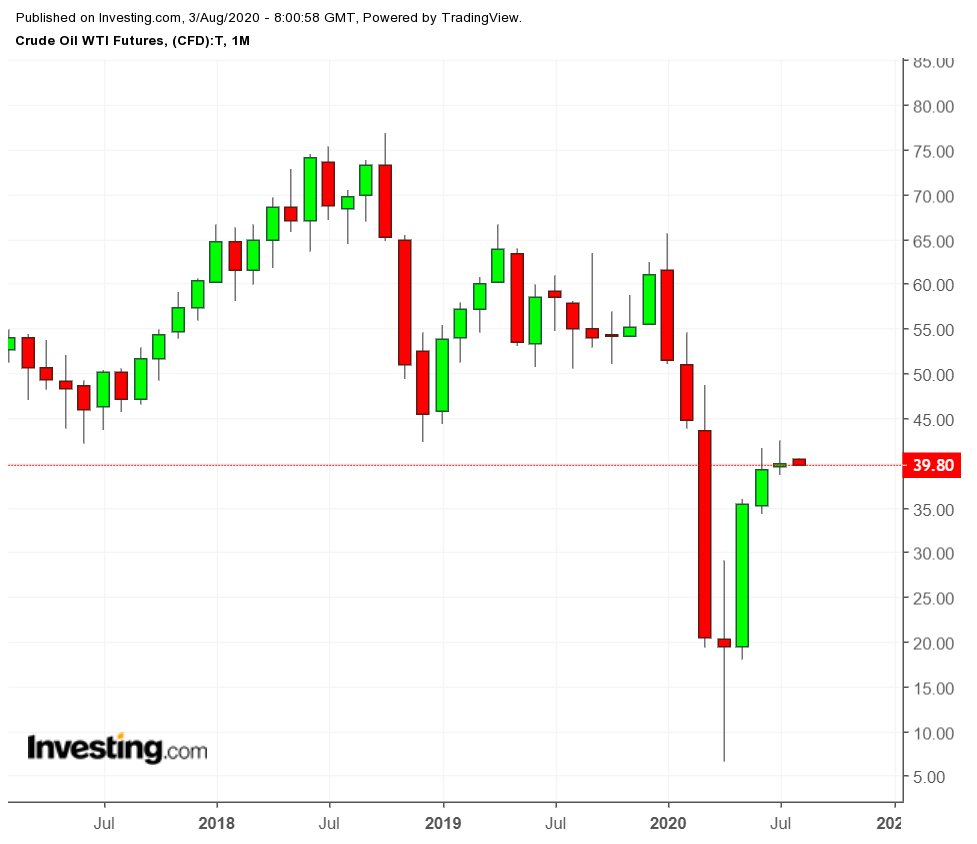Will there be another wild swing in US crude stockpiles this week?
After weeks of out-of-whack numbers from the Energy Information Administration that totally tripped up the market, oil traders are assuming an “anything-goes” situation for the July 27-31 dataset that’s due this week.
While US West Texas Intermediate crude managed to eke out a third straight month of gains in July amid a fourth positive month in a row for its UK peer London-traded Brent, demand uncertainties have cast a pall on crude prices.

The EIA reported two 7-million-barrel draws and one 10 million barrel slump in July versus two builds of nearly 5 million. Both the declines and increases were above levels forecast by analysts.
Volatile Crude Data, OPEC Supply Build Threatens
Like a shadow in the background that could suddenly leap to the forefront depending on how the light is cast, OPEC’s looming supply increase is threatening to shroud any bright fundamentals left in a pandemic-hit oil market that ended July trading up just $1 a barrel.
The Saudi-led Organization of Petroleum Exporting Countries is due to restore 2 million barrels of oil a day to world markets under the terms of its deal on output restraint with non-member allies steered by Russia.
That's coming at a time when the rebound worldwide in fuel demand is under threat from a second wave of COVID-19, as more and more countries—Australia and the UK being the latest—tighten lockdown measures to stop local flare-ups.
“Worries about the trajectory of US growth continue to cap price rises on oil, and those fears are well-founded given the pandemic's inexorable march across the sunbelt states to the Midwest,” said Jeffrey Halley, a Sydney-based analyst at New York’s OANDA.
Hiroyuki Kikukawa, general manager of research at Nissan Securities, had a similar view. He said:
"Investors are worried about oversupply as the OPEC+ is due to start reducing production cuts this month and a recovery in oil prices from record lows is likely to encourage US shale producers to ramp up output."
"Also, fears over a resurgence in the coronavirus cases are weighing on oil markets.”
OPEC’s decision to cut about 7.5 million barrels from August instead of 9.6-million bpd observed since May comes on the heels of data showing the US GDP suffered its worst collapse ever—a drop of nearly 33%—in the second quarter.
“When OPEC Plus decided to raise output early last month, it looked as if the market was going to need those extra barrels,” said Phil Flynn, analyst at the Price Futures Group in Chicago.
“Yet now with more uncertainty about a second wave of the coronavirus and a devastating weekly jobs report, a historically wrong US GDP number, perhaps at this time, a production increase might not be a great idea,” added Flynn, who typically has a bullish outlook on oil.
WTI was down 30 cents, or 0.7%, to $39.97 per barrel by 2:30 PM in Singapore.
Brent slid 22 cents, or 0.5%, to $43.30.
OANDA’s Halley said of the two crude benchmarks, WTI was more vulnerable, with its sliding 200-Day Moving Average pushing for a retest of its $38.80 support.
While Brent has better support, a break below $41.50 could trigger a deeper correction, he added.
Stronger Dollar Weighs On Commodities
Some of oil’s downside this week may be exacerbated by a stronger dollar. After falling to two-week lows last week, the dollar index that is measured against a basket of six currencies was up 0.2% to 93.54.
A more robust dollar could also limit the upside of gold. The most-active December gold contract on Comex—which has attracted higher volumes than new front-month October, hit highs above $2,009 per ounce in Monday’s early trade in Asia.
From modest resistance levels of around $2,010 to highs of $2,200, a huge range has been forecast for December gold’s upside before its expiry two days before New Year’s Eve 2021.
The bulls’ logic is that with the US Congress embarking on another trillion-dollar stimulus—more than $3 trillion have already been issued—it’s a no-brainer to dump the dollar in the emerging hyper-inflationary environment and run to the safety of gold.
Despite that, for every bullish call out there for the yellow metal, there’s a constituency that says the market is overloaded on the top side and a correction of as much as $200 will be triggered soon. Some are not just using hyperbole, but sensible arguments and charts as well, back up their thesis.
Gold’s Range Remains Wide
In this camp is David Lin, associate producer at Kitco News, the media portal run by precious metals trader Kitco. In a blog that ran Friday, Lin reminds us that almost immediately after hitting record highs above $1,900 in September 2011, gold retraced, beginning a long-term bear trend that troughed in December 2015.
But in the same breath, Lin quotes Dan Oliver, founder of Myrmikan Capital, as saying he could see $10,000 an ounce happening, though he doesn't specify when.

“The Fed, as you know, has been on a massive purchasing spree because of the virus situation, and so, therefore, the equilibrium price of gold is going up commensurately, and so the numbers now to balance that balance sheet are enormously high,” Oliver apparently told Lin in an interview. “My [forecast for gold prices] has changed. I’m at $10,000 now.”
Rick Rule, president of Sprott US, also tells Lin that he doesn’t think Oliver’s call is over the top, though he thinks a correction will be necessary before that.
"If you asked me my gold price outlook over the two-year or three-year term, I'm bullish to the point of being wildly bullish," Rule told Lin in an interview, adding that there could be lots of volatility in the coming months.
It has indeed been a parabolic year for precious metals. Silver, the other big winner, took the crown for commodity returns in July, delivering a whopping 34%. September futures on Comex surged from a near 12-year low of $11.65 per ounce in March to a 7-year high of $26.26 an ounce last week. In Monday’s Asian trade, the contract was up 12.1 cents, or 0.5%, at $24.337.
